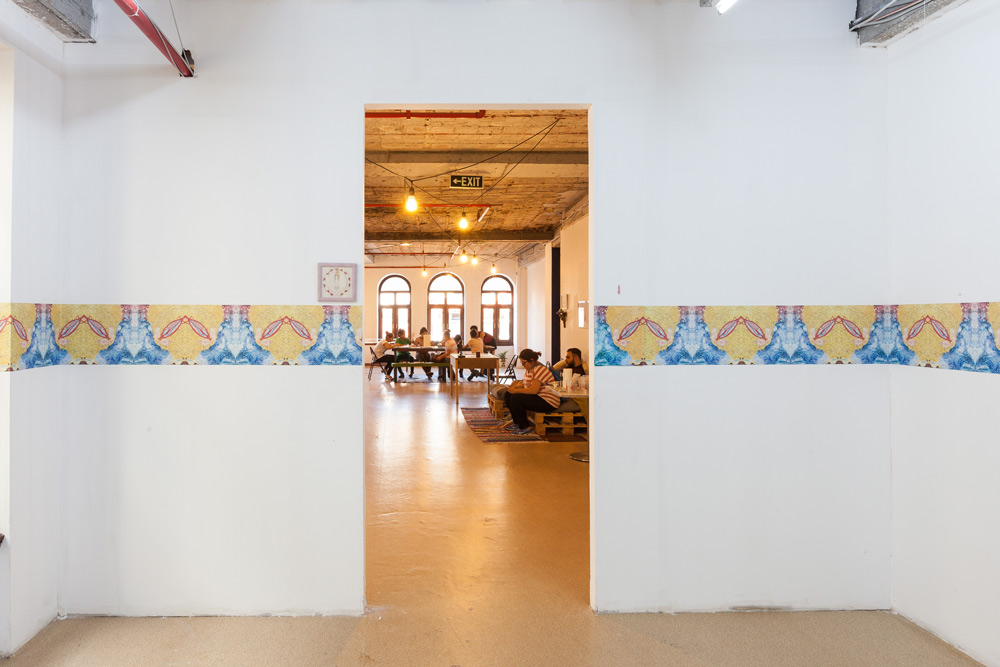To begin, a disclaimer: the Istanbul Biennial comes at a time when it is very hard to focus on artwork. In Istanbul, one is relatively safe, away from the violent turmoil that has overtaken southeastern Turkey (except for the occasional tear gas and the ominous presence of police in city arteries). And of course, anything that is seen or interpreted in this time of unrest—to put it mildly—is refracted through the fog of reality of the place. Thus, “Saltwater: A Theory of Thought Forms“—this year’s Istanbul Biennial, “drafted” by Carolyn Christov-Bakargiev—sits on ever-sliding ground.
This question of the context of content was obliquely directed at Christov-Bakargiev during the event’s opening press conference, when an audience member asked about an email sent by biennial artists Pelin Tan, Anton Vidokle and Artıkişler Kolektifi in which they called for participants of the biennial to “suspend” their involvement for 15 minutes to draw attention to the escalating crisis between the state and PKK, the Kurdistan Workers’ Party. Christov-Bakargiev responded by saying that each artist was free to choose for themselves. I couldn’t help but feel horrible for all of the artists involved—what does it mean to suspend your work, anyway? What does it mean to make work in volatile contexts? Is site-specificity within the biennial context even possible? How do you stay relevant and respectful?
My introspection was precipitated by the ferry ride to the Prince Islands, an hour away from the city centre. The biennial is spread throughout Istanbul, and a huge part of the experience depends on navigating different parts of the city. Flags denote the sites of artworks, prompting a constant sense of discovery. (Whether this scenic experience, choreographed by Christov-Bakargiev, is true to the soul of the ever-expanding city with a not-so-pleasing periphery is up for debate, and perhaps the subject of a longer piece.)
Ed Atkins’s Hisser is housed in an old, dilapidated mansion on the Prince Islands. Here, the artist presents dreamlike images of his avatar falling through a sinkhole and singing what become menacing odes of the Eliotian lonely man. Shown on two floors of the mansion, the work allows viewers either to sit on the floor or pull a chair over from one of the rooms of the mansion that can be perused through. The work is both site-specific and spaceless. While the site adds to the work, the piece stands on its own, encouraging viewers to hum along to the soundtrack and wait for an elusive climax.
The self-conscious and sensitive installation of İz Öztat and Fatima Belkıs is installed in two rooms of the Liceo Italiano, an Italian high school, and on the walls that surround its basketball court. The collaboration between the two artists revolves around their research on the impact of hydroelectric power plants on the communities and environment in Turkey. The minimal use of technology to produce the text and objects of the installation is a crucial reminder of the possibilities that open up when artists make work whose fabrication is mindful of the very issues that they are researching. Everything is informed by the potential of manual methods, with the integration of materials and processes that are unfortunately unfamiliar to many urban dwellers: dyeing fabric, weaving baskets, reproducing text on a typewriter and a mimeograph.
Francis Alÿs’s The Silence of Ani, installed on the ground floor of DEPO, a civically engaged not-for-profit space in Tophane, is a humble yet poignant response to the ruptures in the social fabric that now comprise Turkey. Working with teenagers, the artist made a film about simple instruments that make bird sounds, and shows them being played in the ruins. Alÿs’s film is not about reenactment but activation. The film activates a place that is now empty—a centuries-old Armenian capital. The poetic subtlety of Alÿs’s work is exactly the kind of breathing space that inhabitants of Istanbul need.
Cansu Çakar uses the space on the top floor of a chain shoe retailer located on Istiklal Avenue, arguably the heart of the city. The artist has transformed the open space into a warm, welcoming atelier of drawing and painting for women, functional throughout the course of the biennial. The artists range in age from young girls to women, all looking to pass the time, and they are attributed with photographs of their hands instead of their names, levelling the production of all of those involved, including Çakar herself.
Other highlights include a panoramic, small-scale painting by Bedri Rahmi Eyüboğlu, an Ottoman-born Turkish painter renowned for integrating folk art into his work, as well as his large murals, borrowed from the collection of Füsun Onur, a seminal figure in contemporary art from Turkey, and also one of the participants in the biennial (her small, white fishing boat floats up and down the Bosphorus with a sound installation). Fahrennisa Zeid’s large-scale paintings epitomize formal and conceptual concerns with abstraction. Orhan Pamuk’s notebooks of idiosyncratic drawings and text reveal the Istanbul renowned from his autobiography. Pierre Huyghe’s work—yet to be constructed on the Marmara seabed as a stage for underwater life—tickles dormant, childlike parts of the imagination.
Christov-Bakargiev’s curatorial vision, formed through and by allegiances with different disciplines, organizations and types of practices, has resonance in a city where the spirit of the Gezi Park protests—a horizontal human-rights movement instigated by the desire to protect an urban green space—is being kept alive more than two years later. The relationship between her formidable effort and the city itself, however, remains equivocal. The biennial seems to yearn for the city that was and that could be, missing it for what it is now. Works like Adrián Villar-Rojas’s The Most Beautiful of All Mothers encapsulate this haunting feeling—myth mixed with spectacle and major statements. Such material objects fall flat when set against a place that will always overshadow them.









